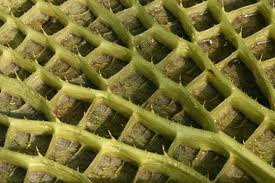.jpg) |
| The giant Amazon water lily |
The water lily house at Kew is as square glazed structure which encloses a circular pond spanning 36 feet. It was completed in 1852 specifically to showcase the giant Amazon water lily. At this time, the Water lily House was at the time the widest single-span glasshouse in the world. Disappointingly, the giant Amazon water lily but the plant never thrived there.
History
 |
| The giant Amazon water lily |
This led to a good deal of confusion over naming of this aquatic giant. According to the arcane but rigid rules of botanical nomenclature it should correctly be called Victoria amazonica but throughout the reign of Queen Victoria it was known as Victoria regia (literally Queen Victoria) and only assumed its botanically correct name after the old Queen died and it was safe to change the labels.
Once the first seeds were brought back to England there was a race amongst the landed gentry to be the first to cultivate the plant and present a flower to the Queen, victory going to the Duke of Devonshire whose head gardener at Chatsworth, Joseph Paxton, built a suitably large glasshouse to accommodate the monster plant ... with no expense spared.
Description
 |
| Underside of the giant Amazon water lily |
The purplish red under-surface has a network of ribs clad in abundant sharp spines, possibly a defence against herbivorous fishes and manatees. Air trapped in the spaces between the ribs enables the leaves to float. They are so buoyant that they can easily support the weight of a small child, and a mature leaf can support 45 kg if the load is evenly distributed. In a single season, each plant produces some 40 to 50 leaves, which cover the water surface and exclude light, thus restricting the growth of most other plants.
Check out the film clip below to view the time lapse opening of giant water lily at Kew Gardens
For further reading click onto:
HOW TO GROW WATER LILIES
HOW TO MAINTAIN AND LOOK AFTER BIOLOGICAL SPONGE POND FILTERS
HOW TO MAINTAIN AND LOOK AFTER A HEALTHY POND
Native British Pond Plants
WHAT CAUSES POND WATER PROBLEMS AND HOW TO AVOID THEM
WHAT IS THE WORLD'S LARGEST LEAF?







No comments:
Post a Comment